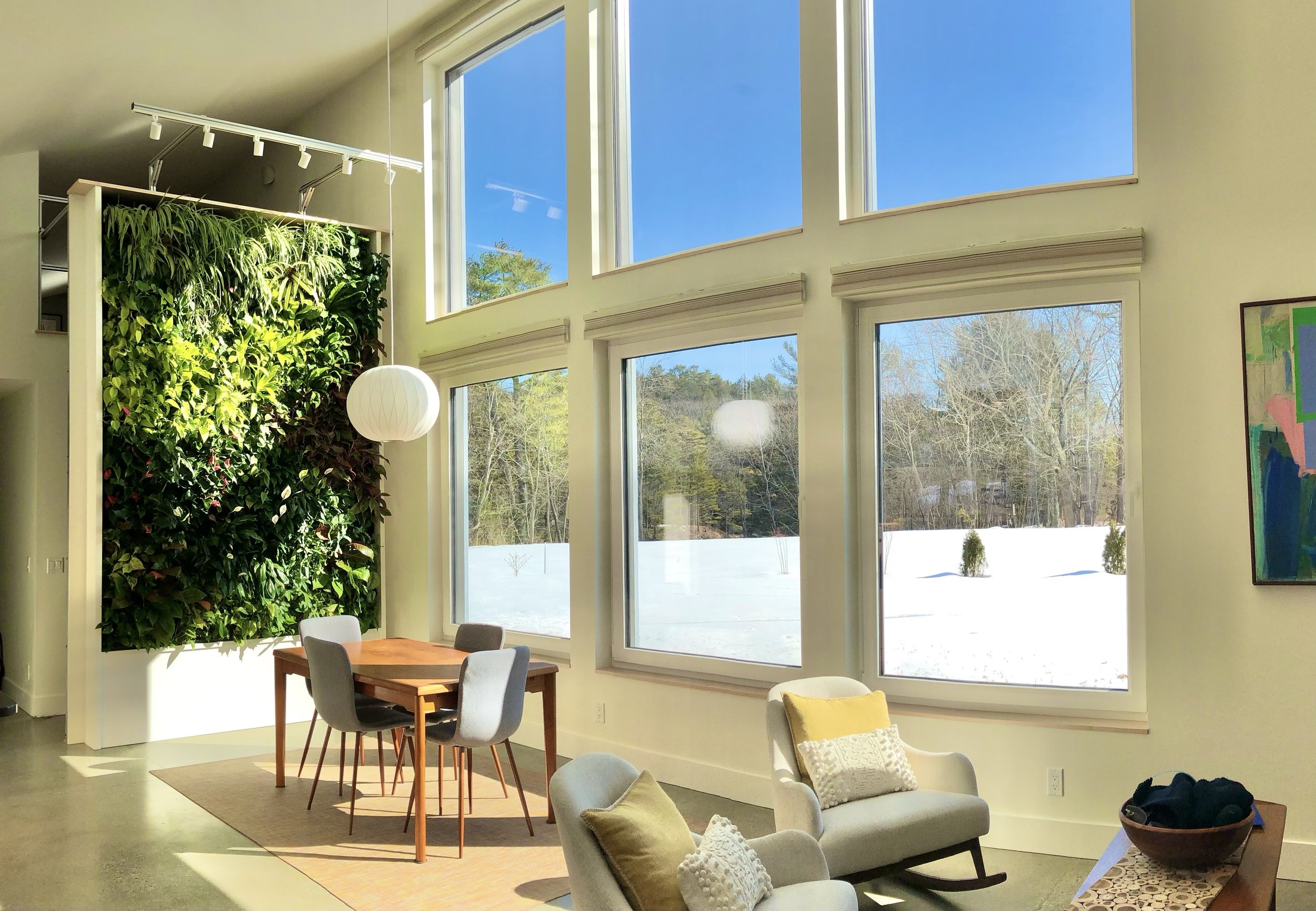Biophilic design brings the outdoors in
The large bank of windows lets visitors revel in the beauty of nature outside, whatever the season, while the living wall of thriving plants enlivens the indoor space year-round. PHOTO COURTESY OF TERRAFLORA
Interior design in harmony with nature
By June Donenfeld
IF YOU’VE EVER LOOKED OVER A VAST EXPANSE of snowy peaks and felt your spirit soar, been filled with profound peace walking through woods with just birdsong for company or felt your heart sing as you gaze at the ocean, you’ve experienced “Friluftsliv” (pronounced free-lufts-leav and translated as “free air life” or “open-air living”). Norwegian playwright Henrik Ibsen coined this phrase in 1859 to describe the physical, psychological and spiritual benefits derived from being in nature, an idea based on the belief that when we spend time in nature we are returning home and helping to achieve balance in our lives.
Other cultures have similar concepts. In Japan, it’s known as shinrin-yoku, or “forest bathing.” Though the term dates to the 1980s, it’s a centuries-old practice for enhancing health, well-being and happiness. Its origins lie in Buddhist nature-connection practices and Shinto religious beliefs about the healing powers of forests and the tree spirits that live there. When you walk slowly and mindfully through the woods, inhaling the air and using all your senses to immerse yourself in the atmosphere and create an emotional connection to nature, you are practicing shinrin-yoku.
The floor-to-ceiling windows look out over tall trees and water, forming a restful backdrop for the restrained furnishings, which themselves recall nature, from the textiles to the ceramics, the place mats to the carved wooden bowl on the wood-grained table top. PHOTO: SEAN LITCHFIELD
A large and growing body of scientific evidence shows that the mental and physical benefits of spending time in the natural world are very real. And you don’t have to leave these benefits behind when you’re indoors. You can use the principles of biophilic design inside your home to make it an uplifting, inspiring and restorative refuge. A relatively recent approach to interiors, biophilic design aims to create a sense of harmony between your home and the world outside through judicious choices around natural elements, including light, form, pattern, color, air quality, scent and sound.
Easy indoor-outdoor access is one way to connect to the natural world. Sliding or French doors can do the trick. If you live in a home surrounded by nature, make the most of it by keeping your windows uncovered as much as possible to let in the outdoor views. As weather conditions permit, keep them open to hear rainfall, wind or birds and to breathe in fresh air. And when they don’t, an air exchanger can provide a continual supply of fresh air, whatever the season.
Light also plays a vital role in biophilic spaces. Natural light—and lots of it—is ideal, but when you can’t get enough because of the weather or during Maine’s dark winters, choose your artificial sources of light carefully, including bulbs, shades and placement.
Strive for a balanced mix of lighting in your home. “Even when you are outdoors you find a variety of light,” says biophilic design specialist Janeen Arnold, founder and principal of Portland interior design firm Salt of Maine Design Co. “Imagine a walk in the woods. There are places where the light trickles through thetrees and others where the space opens up and is far brighter.”
To strike a happy medium, she advises blending a few different light sources in a single room—like task lighting, functional lighting and ambient lighting—and keeping in mind the color temperature of bulbs, too. “Don’t choose ones that are too cool in tone. They tend to make the space feel like a medical facility, which negates the efforts you’ve made to mentally connect it to the outdoors.”
Placing your light sources at different levels will also help create the warm and welcoming atmosphere that’s one of biophilic design’s hallmarks.
Artwork can also have a strong biophilic role to play. “I like to think of the context when selecting pieces,” Arnold says. “How do they help create a connection with the regional landscape?” In Maine, that might mean mountains, forests, lakes or the sea, but she encourages people to take an expansive view of how an artwork can reflect the natural world. “It doesn’t have to be on the nose. I like to find pieces that subtly allude to the landscape outdoors. Think color tones, or how the image resembles outdoor elements or landscapes in an abstract way.”
When it comes to other color choices in your home, “biophilic” doesn’t mean you have to stick to browns and greens (unless you love them). Like artwork, it’s the context that counts, or “regional believability” as Arnold calls it. “In Florida, for example,” she says, “you can get away with bright and saturated colors on a grander scale, whereas I tend to avoid more vibrant colors for homes in Maine, which sees colors for sure, but more subtly.” When choosing your own home’s palette, envision the colors in the Maine landscapes you love—like ocean blues, gray-black granite, forest green or dappled snowy white—and let them be your guide.
Textures and shapes in other home furnishings can echo the natural world, too. Materials such as cotton and linen work well, as does wool or wood: live-edge tables or counters, for instance, are stunning reminders of the trees they came from. Arnold says that she loves to incorporate “textures that link our minds to things we might see along our shores or in our local woods. And, where appropriate, using jute or sisal in wallpaper or rustic wood paneling on the walls or ceiling is a win.” Stones, branches and other natural objects can also reinforce biophilic design and, notes Arnold, “they are far more interesting visually than an artificial object that has no meaning and has been placed there just for decoration.”
Houseplants are another prime way to create a connection to nature, according to biophilic plant design specialists Cheryl Tyler of TerraFlora Design in Brunswick and Mackenzie McKinnon of The Jungle Couch in Portland. If you’re a houseplant novice, Tyler advises doing your homework about a plant’s “native habitat, needs and possible toxicity if there are pets or young children at home. Try the ASPCA for a complete list.”
Bring plants into your home—on flat surfaces, hanging from a ceiling or window frame, or as a lush wall installation—and your space will immediately feel fresher and more uplifting. PHOTO COURTESY OF JUNGLE COUCH
But you don’t have to turn your home into a jungle to reap the benefits. Start with just “a couple of easy-to-care-for plants,” says McKinnon, “and remember if one kind doesn’t make it, try a new variety until you find one that works for you; growing plants is a therapeutic learning experience and should be fun.”
If you want to go further, consider installing plants on a wall. For DIYers, says Tyler, “There are very simple systems that you plug plants into that can have a high visual impact on any space as well as having all the biophilic benefits of calming the nervous system and giving you better focus and cleaner air to breathe.” If you want to put in a more elaborate arrangement or even a full vertical garden (aka living wall), both Tyler and McKinnon advise seeking the help of a professional who will be able to install it and give you guidance on irrigation, lighting and care.
Sound and water are two other biophilic design elements you can use at home. Field recordings from the natural world can transport you to profoundly peaceful—or even stirring—environments without leaving your living room. A small ceramic fountain can soothe you with its gentle splashing even as the clay it’s made from provides a reminder of the earth under your feet.
The renowned architect Frank Lloyd Wright advised his students, “Study nature, love nature, stay close to nature. It will never fail you.” Nor will biophilic design. But you don’t have to implement all its principles in one go. Take your time, make choices that bring you joy, and, step by step, you can create a space that nourishes you, mind, body and soul.
This article appeared in the Spring 2024 edition of Green & Healthy Maine HOMES. Subscribe today!
Find Maine experts that specialize in healthy, efficient homes in the Green Homes Business Directory.






